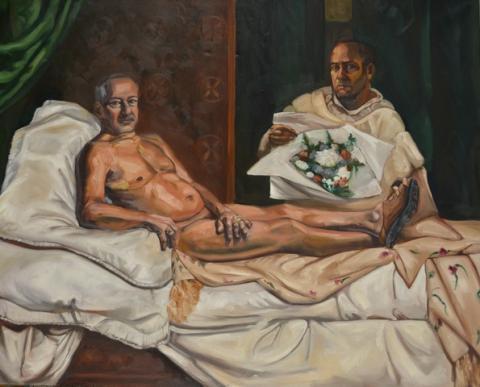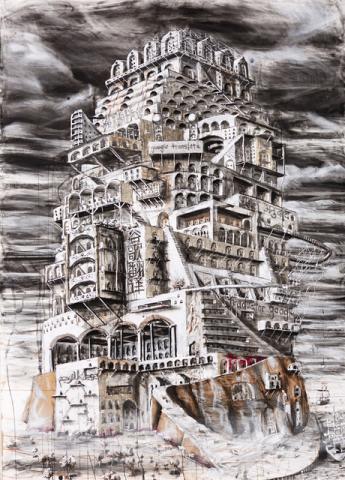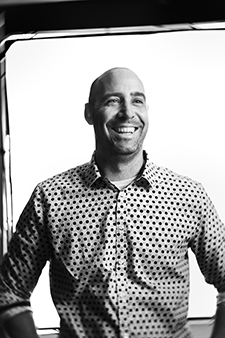2019 Alumni Legacy Award
INTERVIEW BY KERRY MAGUIRE, BFA '18

Melpomene, 2017, mixed media on wood panel, 48”X36”
KERRY MAGUIRE: How did you end up studying at AUArts?
MARK VAZQUEZ-MACKAY: I was fortunate because I already lived in Calgary, in that I was fortunate to be in a city that already had an amazing art school. Studying art was something that… I don’t know if “wanted” to do it is the right word; I had to do it. For me, there was no other option.
Logistically, it’s not easy to make a career as an artist, so I knew early on that I had to pursue as much post-secondary education as I could to arm myself for a career that is otherwise pretty difficult. There’s not necessarily a lot of spots available, you know?
MAGUIRE: I see that you also have an MFA?
VAZQUEZ-MACKAY: I got my Master’s degree and then came back here [to Calgary]. I did my graduate studies at a school called the Instituto Allende, which is in San Miguel de Allende, Mexico. I originally was interested in going to a few European schools, but then I found this program in the middle of Mexico that has a long history with Canadian artists dating back to the 1960s and 1970s, a time before Canada had many MFA programs. A lot of curators and instructors that I had worked with at AUArts went to this school in the 70s, and it also had an affiliation with the School of the Art Institute of Chicago (SAIC).
I had never been to Mexico before I moved. We moved to San Miguel de Allende for two years, and then I taught for one term at the school. We initially moved there — me, my wife and my son, who was 8 months old at the time — with only two bags each. We just went. I doubt I’ll ever be in a situation where I will be able to do something like that again!
MAGUIRE: Thinking back to being at AUArts… I’m always interested in how students’ research and practice changes and evolves over the course of their education. Were you on a path close to what you had predicted? Or did it veer off in ways you didn’t expect, maybe in a way that was influenced by a certain class or professor?
VAZQUEZ-MACKAY: I did have an instructor who had a profound influence over shaping me as an artist: Richard Halliday. He was an exceptional person who understood art in a way that was deeper than I have ever known. He cared for the success of his students and held them to high standards.
I think everyone who goes to AUArts is transformed substantially. I don’t think I am alone in thinking that at AUArts I would be taught how to render something really well, or essentially taught how to create a pretty picture. There were times when I was frustrated that no one specifically taught how to, for example, mix colours. To be honest, I think I might have left there unhappy with what I got from my education.
It took me a few years to realize how much I had got out of my education there. I think it’s taken another 10 years for that to sink in, to really realize how deeply I was transformed at that early stage. I learned to not have any barriers or boundaries in how I conceive of material, or application, or even subject matter. I think in art school you get broken down in order to be rebuilt. No one wants to be broken down, and certainly not in an aggressive way… but wanting to draw like Michaelangelo doesn’t really have much relevance anymore. It was important 500 years ago, but AUArts asked us to think: what is important now? I found myself wanting to be more relevant to the time in which I live, and to the land that I live on. I would say that AUArts taught me how to overall be a creative person.

After Monet, 2012, oil on canvas, 60”X48”
I didn’t come from an art background, and I came to AUArts right out of high school. I had classical idols, and I tended to calibrate what I thought was good and what was not good based on what had been done before, in the past. But that’s just not what’s important; art is about learning about yourself and prioritizing how you interpret the world. Learning this is freeing, but also daunting. When those walls are gone, you can run free, but you don’t know where to run to. You can run anywhere, but you are in this big empty field and there’s no goalpost. Some people freeze, some people run in circles. I’m the person examining every blade of grass in the field, one by one [laughs]. It’s pretty slow going.
My art is all over the place. Of course, that isn’t good for the art market. But I think I am still the same person I was when I graduated: I keep exploring, and I go into depth with ideas, but I have pretty free rein in the media I choose and how I decide to approach my subjects and my research. I still have a hard time putting together a body of work; I don’t know if I ever really have been able to do that with ease. When you graduate, you are expected to shape a body of work. I tried to do this when I graduated from my BFA and my MFA. But I find any body of work I make morphs. It gets abandoned, revisited. I think my retrospective will look like an exhibition by 50 different artists, and I am okay with that now.
MAGUIRE: Since you’ve graduated from school, can you talk about what your creative practice looks like, or how art is involved in your life?
VAZQUEZ-MACKAY: Since graduating, I have had ever-changing ideas of what I want to do. I think some people have these really clear visions of what they want their path to look like following graduation; I’m the opposite. I’m an exploratory artist. I get curious about things. I’ve done all kinds of things: murals, work inside schools, my own work, community projects… and I also have that more classic, solitary studio practice. I’ve done a lot. Every year I take groups of people down to Mexico, to make work in a different environment. It focuses on sketching and sketchbooks.
One of the things I advocate for is for keeping a daily sketchbook; we can understand so much through this process. My studio is absolutely full of sketchbooks; I probably have ten thousand drawings in piles of sketchbooks all around my studio. I don’t do drawings for the sake of producing a piece of art, and I use the term “drawing” very loosely, as often these sketches involve bits of collage or paint. I do [sketching] to retain memories, and to hold on to time, so that I can always be where I was at that specific time through my drawings.
Maybe for some people photography works the same way, but I don’t really think that it’s the same. With photography you have a mechanical device between you and your experiences. Drawing brings me to a place; I can thumb through my drawings and essentially tell you what the space felt like, smelled like, what the chair I was sitting on felt like. It all comes back. I think people are looking for that retention of an experience with photography, but in sketching and physically slowing down in how you document the moment is what really captures the experience. I always emphasize to my students that these drawings don’t have to be good… that’s not what it’s about.
MAGUIRE: Exactly. A quote that is sort of my mantra right now is, “It doesn’t have to be good. It has to be done.”
Do you have any advice for people about to graduate from AUArts, or who have recently graduated?
VAZQUEZ-MACKAY: I think the trick is to stay humble and stay vulnerable. Keep your vulnerability at the front. It’s always going to be hard and scary, even impossible. But I think we have to remain vulnerable to develop ourselves and understand ourselves.

Google Tower, 2017, Mixed media on paper, 60”X48”
MAGUIRE: What does a day in your life look like?
VAZQUEZ-MACKAY: Well, I feel very fortunate that I get to do what I want to do, but that also means that I have to do it all the time. I don’t know if anyone is ever as busy as me. I wake up really early, I go to the gym… not that that’s related to my art practice directly, but I like to wake up quickly and to get going right away. I am a resident artist at a learning through the arts school. I have a large studio at the school, where I have to spend six and a half hours every day. It’s great because it makes me accountable to a space at a certain time, and to the kids who look in the window and make sure I am there making art. Sometimes I am reading or researching, and sometimes I am making.
After that, I eat dinner and I go and teach at AUArts in the evenings. Sometimes it’s three times a week, sometimes four. And then I get home around 10 p.m., and do it all the next morning.
I also mentor two younger artists privately; one is a new Canadian artist. Mentoring is something that I commit quite a bit of time to. I am also a CARFAC Alberta board member, so in-between time goes toward supporting my role there.
MAGUIRE: It sounds like you have every second of your day accounted for!
VAZQUEZ-MACKAY: Yes! My calendar goes about three months into the future. I have friends who want to connect with me, and they laugh when I ask them for a January date [laughs]. But that’s just the reality of it.
MAGUIRE: If someone was thinking about going to art school, how would you communicate the value that your education has had for you, or has generally?
VAZQUEZ-MACKAY: I think when you become an artist, there are a lot of things in society that you no longer need. There’s no void when you are constantly exercising your creativity, when you are making and developing and exploring. You don’t have these voids that the rest of society might have, that they ultimately attempt to fill with material wealth or financial prosperity. I am just happy all the time, pretty much! Granted, I get frustrated or perplexed, or lost… all those feelings that come with being an artist. But I always feel fulfilled as a person.
I am a bit of an existentialist. I examine how people live their lives, and question what we are doing here on earth, and the validity of our pursuits. As an artist, I think we overall have a really positive contribution to our society. Speaking of quotes, you gave one earlier… the one I stumbled on the other day that really stuck with me is, “Art is the highest form of hope” which is from Gerhard Richter. I’d never thought of art as a form of hope before, but it is that idea that it links you to something bigger, something outside of yourself… it gives you access to an intangible other world, and all the experiences that make you excited to be a human.
It’s difficult because the general public still has the notion that I had going into art school: that art is about making an aesthetically pleasing image. The aesthetically pleasing image is valid, but it’s not the end objective. It could be, though; I’ve been floored by beautiful paintings. But that’s just such a small part of the world of art.

Individual group project, 2016, Charcoal on paper, 96”X16”
>>> Meet other Alumni Awards recipients
Mark's Instagram
